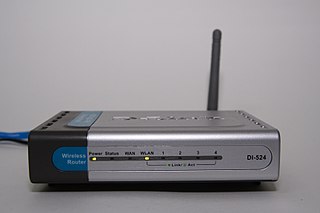H
2O is the chemical formula for water, meaning that each of its molecules contains one oxygen and two hydrogen atoms.
A mirror is an object whose surface reflects an image.
A leap is a jump or big step forward.
Nas is the stage name of American rapper Nasir Jones.

In computer networking, a print server, or printer server, is a type of server that connects printers to client computers over a network. It accepts print jobs from the computers and sends the jobs to the appropriate printers, queuing the jobs locally to accommodate the fact that work may arrive more quickly than the printer can actually handle. Ancillary functions include the ability to inspect the queue of jobs to be processed, the ability to reorder or delete waiting print jobs, or the ability to do various kinds of accounting. Print servers may be used to enforce administration policies, such as color printing quotas, user/department authentication, or watermarking printed documents.

A wireless router is a device that performs the functions of a router and also includes the functions of a wireless access point. It is used to provide access to the Internet or a private computer network. Depending on the manufacturer and model, it can function in a wired local area network, in a wireless-only LAN, or in a mixed wired and wireless network.
Nano, Nano-, NANO or NaNo may refer to:
The University of Michigan College of Engineering is the engineering unit of the University of Michigan in Ann Arbor. With an enrollment of 7,133 undergraduate and 3,537 graduate students, the College of Engineering is one of the premier engineering schools in the United States. The College of Engineering is ranked No. 4 in the United States by U.S. News & World Report in its 2021 publication.

Wireless security is the prevention of unauthorized access or damage to computers or data using wireless networks, which include Wi-Fi networks. The term may also refer to the protection of the wireless network itself from adversaries seeking to damage the confidentiality, integrity, or availability of the network. The most common type is Wi-Fi security, which includes Wired Equivalent Privacy (WEP) and Wi-Fi Protected Access (WPA). WEP is an old IEEE 802.11 standard from 1997. It is a notoriously weak security standard: the password it uses can often be cracked in a few minutes with a basic laptop computer and widely available software tools. WEP was superseded in 2003 by WPA, or Wi-Fi Protected Access. WPA was a quick alternative to improve security over WEP. The current standard is WPA2; some hardware cannot support WPA2 without firmware upgrade or replacement. WPA2 uses an encryption device that encrypts the network with a 256-bit key; the longer key length improves security over WEP. Enterprises often enforce security using a certificate-based system to authenticate the connecting device, following the standard 802.11X.

A home network or home area network (HAN) is a type of computer network that facilitates communication among devices within the close vicinity of a home. Devices capable of participating in this network, for example, smart devices such as network printers and handheld mobile computers, often gain enhanced emergent capabilities through their ability to interact. These additional capabilities can be used to increase the quality of life inside the home in a variety of ways, such as automation of repetitive tasks, increased personal productivity, enhanced home security, and easier access to entertainment.
The NSF Engineering Research Center for Wireless Integrated Microsystems was formed in 2000 in Michigan — through the collaboration of the University of Michigan (UM), Michigan State University (MSU), and Michigan Technological University.
Centennial Communications and its subsidiaries provided wireless and broadband telecommunications services to wireless telephone subscribers in the United States, Puerto Rico, and the U.S. Virgin Islands. On March 13, 2007, Centennial Communications completed the sale of Centennial Dominicana to Trilogy International Partners for approximately $80 million in cash.
Performance-enhancing proxies (PEPs) are network agents designed to improve the end-to-end performance of some communication protocols. PEP standards are defined in RFC 3135 and RFC 3449.
Windows Deployment Services is a server technology from Microsoft for network-based installation of Windows operating systems. It is the successor to Remote Installation Services. WDS is intended to be used for remotely deploying Windows Vista, Windows 7, Windows 8, Windows 10, Windows Server 2008, Windows Server 2012 and Windows Server 2016, but also supports other operating systems because unlike its predecessor RIS, which was a method of automating the installation process, WDS uses disk imaging, in particular the Windows Imaging Format (WIM). WDS is included as a Server Role in all 32-bit and 64-bit versions of Windows Server 2008, and is included as an optionally installable component with Windows Server 2003 Service Pack 2.
Cable & Wireless refers to three telecommunications businesses:
The Magic Keyboard may refer to:
This page is based on this
Wikipedia article Text is available under the
CC BY-SA 4.0 license; additional terms may apply.
Images, videos and audio are available under their respective licenses.



